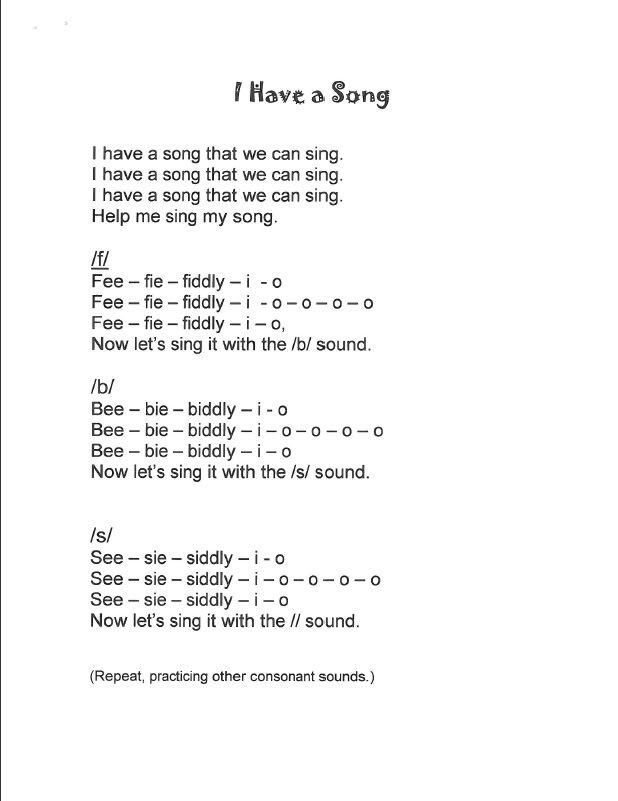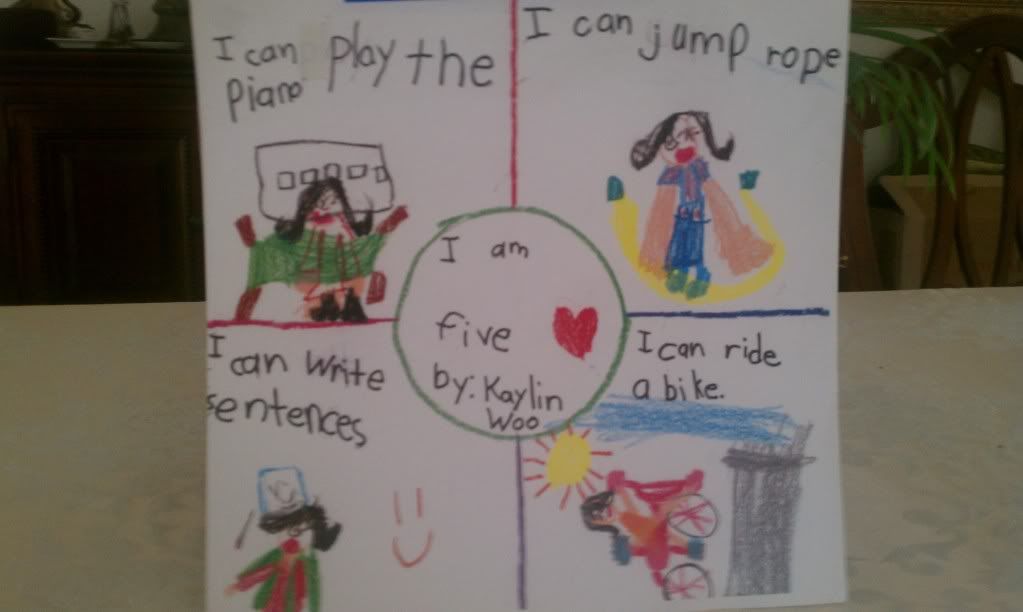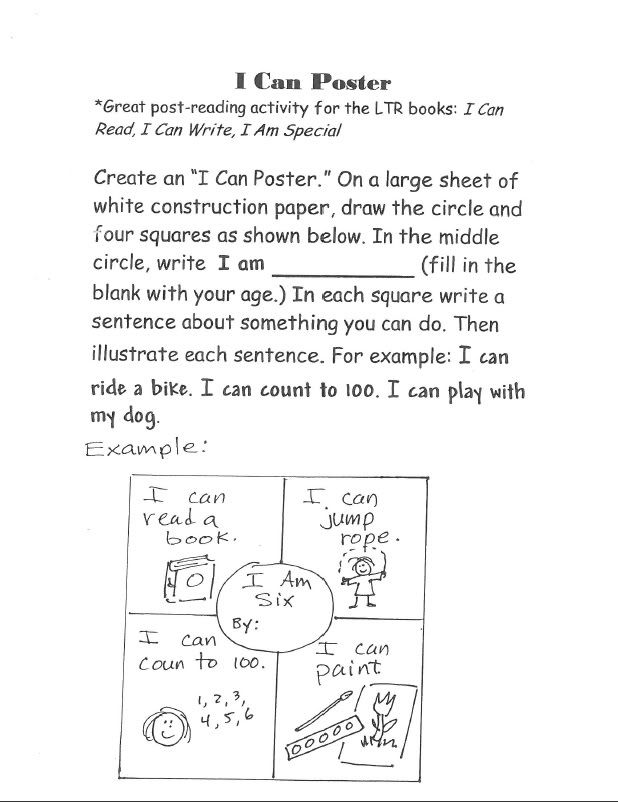Monday, April 23, 2012
Write a Five Senses Poem
_____________ (title)
I see ______________.
I smell _______________.
I hear _____________.
I feel ______________.
I taste _____________.
I know _______________.
Example
Spring
I see green buds on the trees.
I smell purple lilacs on a bush.
I hear "chirp chirp."
I feel a warm breeze on my face.
I taste raindrops on my tongue.
I know winter is over and spring is here!
Set Up a Poetry Corner in Your Classroom
* Designate a corner of the classroom as a hands-on poetry corner. Place a poetry box on a table or desk so students can have easy access to it.
* Display a variety of poetry anthologies or collections.
* Develop sensory awareness by creating a seasonal display using plants, fresh flowers, dried flowers, interesting nature items such as rocks, leaves, shells, etx.
* Choose a poem as the special focus for the day or week. Display the poem in the poetry corner. Leave blank space next to the focus poem so that children can attach poems they have found with a similar theme, original "response" poems or their own artistic interpretations of the poem.
* Provide lots of paper in various sizes, shapes, and colors for children to use when writing their own poems.
* Keep a large jar, empty aquarium, or basket at the poetry corner. Ask a different child each day to bring something to put into the conatainer. (Examples: a toy airplane, seashell, clay dinosaur, bird's nest, or other realia.) When the teacher takes a turn, he/she could surprise the class with a turtle, fish, hermit crab, or the like. Challenge students to find, recite and display poems that describe the object in the basket. Whenever children have free time, they may want to sit at the poetry corner, reflect on something in the display (or classroom environment), and write a poetic description of what they see.
* Display a variety of poetry anthologies or collections.
* Develop sensory awareness by creating a seasonal display using plants, fresh flowers, dried flowers, interesting nature items such as rocks, leaves, shells, etx.
* Choose a poem as the special focus for the day or week. Display the poem in the poetry corner. Leave blank space next to the focus poem so that children can attach poems they have found with a similar theme, original "response" poems or their own artistic interpretations of the poem.
* Provide lots of paper in various sizes, shapes, and colors for children to use when writing their own poems.
* Keep a large jar, empty aquarium, or basket at the poetry corner. Ask a different child each day to bring something to put into the conatainer. (Examples: a toy airplane, seashell, clay dinosaur, bird's nest, or other realia.) When the teacher takes a turn, he/she could surprise the class with a turtle, fish, hermit crab, or the like. Challenge students to find, recite and display poems that describe the object in the basket. Whenever children have free time, they may want to sit at the poetry corner, reflect on something in the display (or classroom environment), and write a poetic description of what they see.
Thursday, April 19, 2012
April is National Poetry Month!
Hello fellow poetry lovers. Let's celebrate this special month. Remember . . .
"All good writing is poetry driven." --Deidre Spicer
Every day for the remainder of the month, I will post something poetic in nature to inspire you and share with your students.
I Love to Write!
I write a list when I want to bake.
I write a postcard when I'm at the lake.
I write in my journal every day.
I write when I have something important to say.
I write a card just to say hello.
I write a report about what I know.
I write a note when I'll be late.
I write when I want to communicate!
RLW
"All good writing is poetry driven." --Deidre Spicer
Every day for the remainder of the month, I will post something poetic in nature to inspire you and share with your students.
Here are two poems featuring reading and writing . . . Reading Is Fun
I can read about pirates.
I can read about dogs.
I can read about insects.
I can read about frogs.
I can read LOTS of books, not just one.
I love to read. Reading is FUN!
RLW
I Love to Write!
I write a list when I want to bake.
I write a postcard when I'm at the lake.
I write in my journal every day.
I write when I have something important to say.
I write a card just to say hello.
I write a report about what I know.
I write a note when I'll be late.
I write when I want to communicate!
RLW
Wednesday, March 14, 2012
15 Simple Ways to Increase Comprehensible Input
(Stephen Krashen, 1981)
I found this in my files, and I thought about how relevent it is, not just for ESL students, but in ALL classroom settings. BTW, if you want to learn more about this topic, TeacherVision website has some great info. Here's the link: http://www.teachervision.fen.com/learning-disabilities/bilingual-education/10260.html
1. Read often, start with picture books.
2. Slow down (speak more slowly, not more loudly).
3. Use shorter sentences.
4. Demonstrate.
5. Place or hang visual cues in the classroom.
6. Use hands-on activities.
7. Make frequent checks for comprehension.
8. Use realia, photos, or actual objects.
9. Display language and content objectives.
10.Avoid idioms and slang.
11. Use appropriate gestures.
12. Scaffold with guided questions and practice.
13. Cooperative learning
14. Activate and build on prior knowledge.
15 Remember, a smile goes a long way! :-)
I found this in my files, and I thought about how relevent it is, not just for ESL students, but in ALL classroom settings. BTW, if you want to learn more about this topic, TeacherVision website has some great info. Here's the link: http://www.teachervision.fen.com/learning-disabilities/bilingual-education/10260.html
1. Read often, start with picture books.
2. Slow down (speak more slowly, not more loudly).
3. Use shorter sentences.
4. Demonstrate.
5. Place or hang visual cues in the classroom.
6. Use hands-on activities.
7. Make frequent checks for comprehension.
8. Use realia, photos, or actual objects.
9. Display language and content objectives.
10.Avoid idioms and slang.
11. Use appropriate gestures.
12. Scaffold with guided questions and practice.
13. Cooperative learning
14. Activate and build on prior knowledge.
15 Remember, a smile goes a long way! :-)
Tuesday, February 21, 2012
Focus on Phonemic Awareness
Activities for parents and teachers of pre-schoolers:
Along with reading aloud to your pre-schoolers every day, there are a few fun and easy activities that you can do to greatly enhance the your child's reading success in kindergarten and 1st grade. These activities are meant to teach a skill called phonemic awareness.
Phonemic awareness is the ability to hear and manipulate the individual sounds that make up spoken words. These are auditory activities and can be performed anywhere: in line at the supermarket, in the car, or when taking walks together.
Rhyme Time! I once worked with a 1st greade teacher who used to say, "If they can rhyme, they can read." Dr. Seuss books are great rhyming read-alouds.
* Make up short little rhymes and invite your child to guess the rhyming word. "There once was a little mouse that lived in a little ______."
* Chant and sing nursery rhymes.
* Say three words, such as cat, mat, mug. Ask your child to pick the word that doesn't rhyme.
* Say 3 words, such as bug, cat, baby, and have your child pick the word that starts with a different sound.
Focus on Sounds. Invite your child to guess the word when you divide it up into the sounds, such as /mmmmmmaaaaaannnnn/ man. Or ask your child what sound, not letter, they hear at the beginning of man, moon, monkey and so on.
Songs and Word Play! Recite fun tongue twisters with your child. Remember Peter, who picked a peck of pickled peppers? Swap beginning letters on common prhases such as "Bappy Hirthday!" or "Have a dice nay! Here is a great song that builds phonemic awareness. Sing it to the last part of the song, "I've Been Workin' on the Railraod." Download this song now!
Click image to download
song for phonemic awareness.
For more songs and activities, google "Phonemic Awareness Activities."
Tuesday, February 14, 2012
First Grade Writing Samples
For how to get started with daily journals in the K-1 classroom, check out my posting and free download from Jan. 11, 2012. Now enjoy this amazing writing...
Thursday, February 9, 2012
A Great K-1 Graphic Organizer to Plan Writing
This is a super activity for the beginning of the school year as well as for Open House in the Spring. Each child can create an "All About Me" poster using the graphic organizer like the one below. Invite each child to present his/her poster to foster oral language development. Then, each student can refer to the poster when writing a descriptive paragraph.
Click image to download
this reproducible.
Subscribe to:
Posts (Atom)





